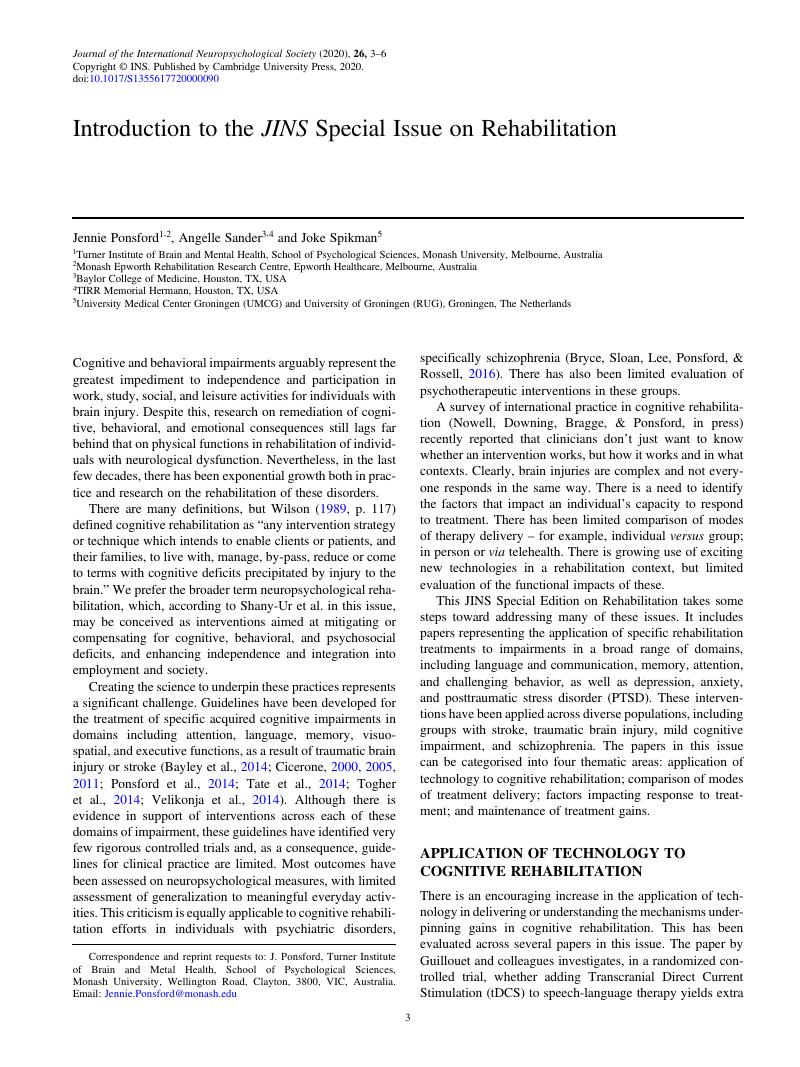No CrossRef data available.
Article contents
Introduction to the JINS Special Issue on Rehabilitation
Published online by Cambridge University Press: 27 January 2020
Abstract
An abstract is not available for this content so a preview has been provided. Please use the Get access link above for information on how to access this content.

- Type
- Introduction
- Information
- Journal of the International Neuropsychological Society , Volume 26 , Special Issue 1: Rehabilitation , January 2020 , pp. 3 - 6
- Copyright
- Copyright © INS. Published by Cambridge University Press, 2020.
References
REFERENCES
Bayley, M.T., Tate, R., Douglas, J.M., Turkstra, L.S., Ponsford, J., Stergiou-Kita, M., Kua, A., Bragge, P., & INCOG Expert Panel (2014). INCOG guidelines for cognitive rehabilitation following traumatic brain injury: Methods and overview. Journal of Head Trauma Rehabilitation, 29(4), 290–306.CrossRefGoogle Scholar
Bryce, S., Sloan, E., Lee, S., Ponsford, J., & Rossell, S. (2016). Cognitive remediation in schizophrenia: A methodological appraisal of systematic reviews and meta-analyses. Journal of Psychiatric Research, 75, 91–106.CrossRefGoogle Scholar
Cicerone, K.D., Dahlberg, C., Kalmar, K., Langenbahn, D.M., Malec, J.F., Bergquist, T.F., Felicetti, T., Giacino, J.T., Harley, J.P., Harrington, D.E., Herzog, J., Kneipp, S., Laatsch, L., & Morse, P.A. (2000). Evidence-based cognitive rehabilitation: Recommendations for clinical practice. Archives of Physical Medicine and Rehabilitation, 81(12), 1596–1615.CrossRefGoogle Scholar
Cicerone, K.D., Dahlberg, C., Malec, J.F., Langenbahn, D.M., Felicetti, T., Kneipp, S., Ellmo, W., Kalmar, K., Giacino, J.T., Harley, J.P., Laatsch, L., Morse, P.A., & Catanese, J. (2005) Evidence-based cognitive rehabilitation: Updated review of the literature from 1998 through 2002. Archives of Physical Medicine and Rehabilitation, 86(8), 1681–1692.CrossRefGoogle Scholar
Cicerone, K.D., Langenbahn, D.M., Braden, C., Malec, J.F., Kalmar, K., Fraas, M., Felicetti, T., Laatsch, L., Harley, J.P., Bergquist, T., Azulay, J., Cantor, J., & Ashman, T. (2011). Evidence-based cognitive rehabilitation: Updated review of the literature from 2003 through 2008. Archives of Physical Medicine and Rehabilitation, 92(4), 519–530.CrossRefGoogle Scholar
Cullen, N., Chundamala, J., Bayley, M., Jutai, J., Erabi Group (2007). The efficacy of acquired brain injury rehabilitation. Brain Injury, 21(2), 113–32.CrossRefGoogle Scholar
Nowell, C., Downing, M., Bragge, P., Ponsford, J. (2019). Current practice of cognitive rehabilitation following traumatic brain injury: An international survey. Neuropsychological Rehabilitation [Epub ahead of print]. Published online 5 June 2019. doi: 10.1080/09602011.2019.1623823
CrossRefGoogle Scholar
Ponsford, J., Bayley, M., Wiseman-Hakes, C., Togher, L., Velikonja, D., McIntyre, A., Janzen, S., Tate, R., & INCOG Expert Panel (2014). INCOG recommendations for management of cognition following traumatic brain injury, part II: Attention and information processing speed. Journal of Head Trauma Rehabilitation, 29(4), 321–337.CrossRefGoogle Scholar
Tate, R., Kennedy, M., Ponsford, J., Douglas, J., Velikonja, D., Bayley, M., & Stergiou-Kita, M. (2014). INCOG recommendations for management of cognition following traumatic brain injury, part III: Executive function and self-awareness. Journal of Head Trauma Rehabilitation, 29(4), 338–352.CrossRefGoogle Scholar
Togher, L., Wiseman-Hakes, C., Douglas, J., Stergiou-Kita, M., Ponsford, J., Teasell, R., Bayley, M., Turkstra, L.S., & INCOG Expert Panel (2014). INCOG recommendations for management of cognition following traumatic brain injury, part IV: Cognitive communication. Journal of Head Trauma Rehabilitation, 29(4), 353–368.CrossRefGoogle Scholar
Turner-Stokes, L., Pick, A., Nair, A., Disler, P.B., & Wade, D.T. (2015). Multi-disciplinary rehabilitation for acquired brain injury in adults of working age. The Cochrane Database of Systematic Reviews, (12), CD004170. https://doi.org/10.1002/14651858.CD004170.pub3
Google Scholar
Velikonja, D., Tate, R., Ponsford, J., McIntyre, A., Janzen, S., Bayley, M., & INCOG Expert Panel (2014). INCOG recommendations for management of cognition following traumatic brain injury, part V: Memory. Journal of Head Trauma Rehabilitation, 29(4), 369–386.CrossRefGoogle Scholar
Wilson, B.A. (1989). Models of cognitive rehabilitation. In Wood, R.L. & Eames, P. (Eds.), Models of brain injury rehabilitation, (pp. 117–141). London: Chapman & Hall.Google Scholar




